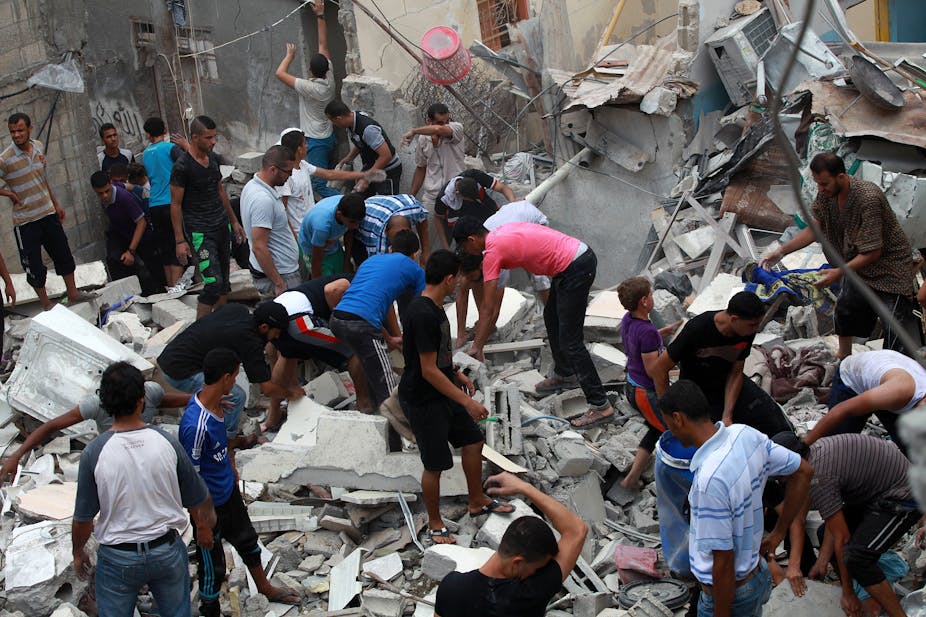It is three weeks since the current Israeli offensive against Gaza began on July 8. But it is now eight years since Israel began its blockade of Gaza. Since then unemployment has risen, public infrastructure has crumbled and civil service employees have not received salaries regularly since August 2013, and none at all since April 2014. With the prospects for peace still looking remote, the public health implications of the blockade of the Gaza Strip and the current war are vast.
This attrition of the public health environment has made the population of Gaza more vulnerable than ever. And it’s not just the obvious direct casualties of war; Israel’s bombardment of the Gaza strip has numerous knock-on effects on the long-term health situation.
Direct casualties
As of August 4, data from the UN Office for the Coordination of Humanitarian Affairs indicates Palestinian fatalities stand at 1,717, of which at least 68% were civilians. These include 573 women and children. Israeli fatalities number 64 soldiers and three civilians.
These figures portray a shocking direct impact of the war on the civilian population of Gaza and raise questions about the legality of the tactics employed by Israeli forces.
Impacts on medical care
Attacks on medical facilities, ambulances and medical staff have repeatedly occurred since the conflict began. Such that the International Committee of the Red Cross issued a statement on July 10 calling on all sides in the conflict to protect civilians and medical workers. Since then, attacks against Palestinian medical workers and facilities have persisted.
Not only does this impair acute trauma care for war injuries, but also other routine and emergency medical care. For example, diabetics and people with hypertension require continued access to life saving medication and mothers require access to obstetric care.
Degradation of water and sanitation
Water treatment and distribution infrastructure have apparently been deliberately targeted and severely degraded, raising the prospect of severe water shortages. The Gaza Strip now has less than 20% of the limited electricity supplies it had before the conflict began.
This has devastating knock-on effects. Without power, even the pumping stations that remain intact cannot work, and the supply of safe water is further reduced. Hospitals also cannot function effectively, as they are effected both by a loss of water supplies and by a loss of electrical power.
Destruction of housing
On August 1 the UN Relief and Works Agency for Palestinian Refugees in the Near East reported that 225,178 people had been displaced from their homes and were sheltering in 86 shelters. It is likely that a full count of destroyed and damaged houses will not be possible until hostilities cease. High profile attacks on UN schools that were acting as shelters for displaced people have also occurred, leading to a generalised climate of uncertainty and fear.
Loss of housing and people being displaced into crowded shelters, with inadequate space, sanitation and hygiene facilities risks increased transmission of infectious disease and the possibility of outbreaks. Loss of one’s home and possessions through violent destruction also may have a huge impact on the mental health of individuals.
Impacts on mental health
The impact of war on mental health and how it applies in Gaza have already been discussed. As the conflict continues it seems likely that effects on mental health will be exacerbated.
One can reasonably speculate that running parallel to this will be an increased hardening of attitudes and a heightened motivation to fight back against those perceived as perpetrators.
Food and nutrition security
Having an adequate nutritional intake is not just about the availability of food of adequate quality. It also requires that people have proper access to food. So, shops and markets need to be open, people need to be able to move around and buy what they need, and then they must have the facilities to prepare and eat it.
This also requires water, as well as fuel. As the war continues and more infrastructure is destroyed, hunger and malnutrition may start to rise. Unfortunately, a number of markets have already been bombed by Israeli forces and water is already running short in large areas of Gaza. Even with the possibility of a seven-hour “humanitarian window” granted by Israel for parts of the Gaza Strip, this is but a temporary respite and the food and aid that can be brought in will have a limited effect on the long-term situation.
Israel’s blockade
The public health impacts of war are almost always severe but if the war continues in the crowded urban environments of Gaza they will be horrific. Even if there is a halt to the immediate Israeli assault the prospects for Gazans are grim, unless an end to the Israeli blockade can be achieved.
The use of blockades as a military or political tactic is as old as organised warfare itself. In the case of Gaza, the blockade has clearly been seen by Israel as a useful long term tool for achieving its objectives, despite the huge cost to the public health of Gaza’s people. But as the eyes of the world turn to Gaza during this current phase of conflict, and Israeli political capital is diminished by each report of attacks against civilians, the sustainability of their policy must surely be subject to debate.
Without meaningful negotiations between Israel and the de facto government in Gaza the prospects for a sustainable ceasefire seem remote. Without serious pressure being applied by the key international governments that materially support and sustain the current status quo, meaningful negotiations appear a remote possibility. The public health implications of this current state of affairs are frightening.

